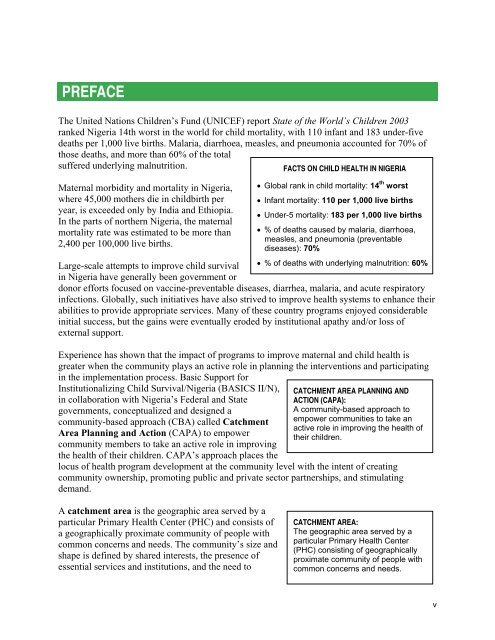The CAPA Handbook: A "How-to" Guide for Implementing ... - basics
The CAPA Handbook: A "How-to" Guide for Implementing ... - basics
The CAPA Handbook: A "How-to" Guide for Implementing ... - basics
Create successful ePaper yourself
Turn your PDF publications into a flip-book with our unique Google optimized e-Paper software.
PREFACE<br />
<strong>The</strong> United Nations Children’s Fund (UNICEF) report State of the World’s Children 2003<br />
ranked Nigeria 14th worst in the world <strong>for</strong> child mortality, with 110 infant and 183 under-five<br />
deaths per 1,000 live births. Malaria, diarrhoea, measles, and pneumonia accounted <strong>for</strong> 70% of<br />
those deaths, and more than 60% of the total<br />
suffered underlying malnutrition.<br />
FACTS ON CHILD HEALTH IN NIGERIA<br />
Maternal morbidity and mortality in Nigeria,<br />
where 45,000 mothers die in childbirth per<br />
year, is exceeded only by India and Ethiopia.<br />
In the parts of northern Nigeria, the maternal<br />
mortality rate was estimated to be more than<br />
2,400 per 100,000 live births.<br />
Large-scale attempts to improve child survival • % of deaths with underlying malnutrition: 60%<br />
in Nigeria have generally been government or<br />
donor ef<strong>for</strong>ts focused on vaccine-preventable diseases, diarrhea, malaria, and acute respiratory<br />
infections. Globally, such initiatives have also strived to improve health systems to enhance their<br />
abilities to provide appropriate services. Many of these country programs enjoyed considerable<br />
initial success, but the gains were eventually eroded by institutional apathy and/or loss of<br />
external support.<br />
Experience has shown that the impact of programs to improve maternal and child health is<br />
greater when the community plays an active role in planning the interventions and participating<br />
in the implementation process. Basic Support <strong>for</strong><br />
Institutionalizing Child Survival/Nigeria (BASICS II/N),<br />
in collaboration with Nigeria’s Federal and State<br />
governments, conceptualized and designed a<br />
community-based approach (CBA) called Catchment<br />
Area Planning and Action (<strong>CAPA</strong>) to empower<br />
community members to take an active role in improving<br />
the health of their children. <strong>CAPA</strong>’s approach places the<br />
• Global rank in child mortality: 14 th worst<br />
• Infant mortality: 110 per 1,000 live births<br />
• Under-5 mortality: 183 per 1,000 live births<br />
• % of deaths caused by malaria, diarrhoea,<br />
measles, and pneumonia (preventable<br />
diseases): 70%<br />
CATCHMENT AREA PLANNING AND<br />
ACTION (<strong>CAPA</strong>):<br />
A community-based approach to<br />
empower communities to take an<br />
active role in improving the health of<br />
their children.<br />
locus of health program development at the community level with the intent of creating<br />
community ownership, promoting public and private sector partnerships, and stimulating<br />
demand.<br />
A catchment area is the geographic area served by a<br />
particular Primary Health Center (PHC) and consists of<br />
a geographically proximate community of people with<br />
common concerns and needs. <strong>The</strong> community’s size and<br />
shape is defined by shared interests, the presence of<br />
essential services and institutions, and the need to<br />
CATCHMENT AREA:<br />
<strong>The</strong> geographic area served by a<br />
particular Primary Health Center<br />
(PHC) consisting of geographically<br />
proximate community of people with<br />
common concerns and needs.<br />
v

















